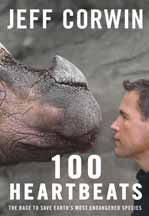SEJournal Online is the digital news magazine of the Society of Environmental Journalists. Learn more about SEJournal Online, including submission, subscription and advertising information.

BookShelf
100 Heartbeats: A Journey to Meet Our Planet's Endangered Animals and the Race To Save Earth's Most Endangered Species
By Jeff Corwin
Rodale, $24.99
Reviewed by JENNIFER WEEKS
If you didn't know that Jeff Corwin was an Emmy-winning producer and television host, you might come away from reading 100 Heartbeats convinced that he was a conservationist with a bad case of Attention Deficit Disorder. One minute he's tracking polar bears above the Arctic Circle; then suddenly he's riding in a jeep through the forest in India looking for Bengal tigers. After a few pages about habitat fragmentation and poaching, he turns up at a zoo in Spain that breeds endangered Iberian lynxes. Like a television newscast, the book is riddled with jump cuts and abrupt transitions.
But Corwin has a theme: human impacts have created a major crisis for biodiversity on Earth. His book is about members of what he calls the "Hundred Heartbeat Club," a term borrowed from biologist E.O. Wilson to describe critically endangered species that have 100 or fewer individuals alive in the wild today. Corwin has seen many animals that belong to the club or may join it soon and he uses their stories to illustrate the many threats driving them to extinction.
He leavens the gloom with stories about conservationists working to save threatened species. "[E]very day presents opportunities for us to make a resounding difference in their lives and their future as species," he writes. From panda reserves in China to captive black-footed ferret breeding programs in Wyoming, Corwin musters plenty of examples to show that human intervention can make a difference. But he's also realistic: once we've interfered drastically with a species, he points out, there are no quick fixes – long-term management is the only option.
100 Heartbeats is (loosely) structured as an overview of human-generated threats that are driving many species toward extinction. It's a sorry list that includes climate change, habitat loss and fragmentation, pollution, introduced species, and over-hunting, to name just a few of the biggest drivers. Each section is illustrated with animal encounters and vignettes from Corwin's global reporting.
Many of these close-ups are poignant, like an encounter with Lonesome George, the last giant Abingdon Island tortoise — a subspecies found on one of the Galapagos Islands. George lives at the Charles Darwin Research Station, and researchers are looking for closely related female tortoises that they can mate with him and keep his genetic line going at least one generation longer. He's only 90-something (giant tortoises are thought to live for 150 years or more), so there's still time.
There's also Booming Ben, the last heath hen that remained on Martha's Vineyard in the 1920s after his species had been eradicated on the mainland. For five years, Corwin writes, Ben came to the hens' spring lekking (mating ground) to dance: "He boomed out his mating call again and again, unaware that there were no other heath hens to hear him," before he died in 1932.
Many of Corwin's stories touch on scientific problems, such as how chytrid fungus attacks and kills frogs, or the harmful impacts when keystone species are removed from an ecosystem. The anecdotes are bite-sized, but they show how many unintended consequences have resulted from human actions like over-hunting and importing species around the world.
Corwin's writing is uneven. Sometimes he uses vivid metaphors to put readers in the scene: for example, describing bald eagles' seven-foot nests, he recalls, "The first time I climbed inside one, I felt like I was Alice in Wonderland after eating the mushroom that made her very small." But he also can turn clichéd and clunky, writing that seeing an eagle in the wild "feeds my soul," or asking rhetorical questions such as "How can we reconcile the moral chasm that lies between a 5,000-pound rhino carcass and a few harvested horns?"
Even when the phrasing gets awkward, though, Corwin's sincerity feels genuine and unforced. And he doesn't just say that we need to do better — he also rightly points out that conservation policies are most effective when they motivate people to change their behavior. For example, he argues, the best way to stem the African trade in bushmeat (meat from non-game wild animals like chimpanzees) is not just to ban the practice but to give people other sources for income and protein.
This book isn't the source for in-depth case studies or big policy solutions, but it's a good survey of threats to endangered species and some creative rescue initiatives. If you're new to writing about wildlife conservation, it's a good jumping-off point. If you already know the field, you may get inspired to extend some of Corwin's stories where he leaves off, or to track down the next candidate for the Hundred Heartbeat Club.
Freelancer Jennifer Weeks lives and writes in Watertown, Massachusetts.
** From the quarterly newsletter SEJournal, Spring 2010 issue.











 Advertisement
Advertisement 



